HTC Thunderbolt Review: The First Verizon 4G LTE Smartphone
by Brian Klug on April 27, 2011 12:12 AM EST- Posted in
- Smartphones
- HTC
- Verizon
- LTE
- 4G
- Android
- HTC Thunderbolt
- Mobile
- MDM9600
- MSM8655
So I have a confession to make - I’m late on this one. Way late. I managed to catch strep throat, came down with a high fever, then a sinus infection, and as a result missed my goal of having everything Verizon 4G LTE - including the HTC Thunderbolt - wrapped up and published a few weekends ago. One thing led to the other, and I promised a number of readers both in emails and on Twitter that it would be done a long time before it ended up coming to fruition. I think I’m going to add a week to all time estimations from now on, just to be safe. Apologies if I made you refresh obsessively a few times there.
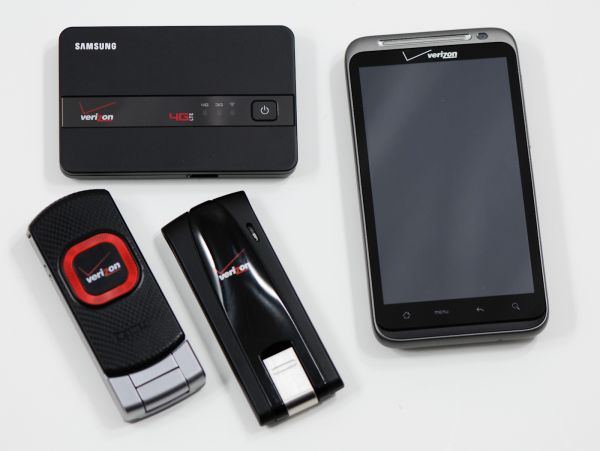
Clockwise from top left: Samsung SCH-LC11, HTC Thunderbolt, Verizon USB551L, Pantech UML290
That said, it isn’t entirely a loss. Over the past month, I somehow have found myself getting slowly buried in literally every single Verizon 4G LTE device (with the exception of the LG VL600 data card) and that’s a good position to be in. The story of our LTE testing started actually before MWC with the Pantech UML290, and since then each time a new device has shown up, I’ve hopped in my car, driven two hours to Phoenix (the nearest LTE market) and spent a sleepless 48 hours testing battery life, speeds, and stability. It’s been a lot of testing, driving, and collecting data. I’ve recorded 542 speed test runs on 4G LTE as a result, and many more on EVDO for comparison. There’s a ton of stuff to go over, so to keep things manageable, I’ve split the review down the middle. This half is HTC Thunderbolt, the other is everything about Verizon 4G LTE from a cellular perspective including two data cards and a WiFi hotspot.
Without any more rambling, let’s get into this review of the first LTE-enabled smartphone on Verizon.
The first thing to say about the HTC Thunderbolt is that it’s gigantic. It’s big simply by virtue of having two transceivers inside, and four antennas. The fact that it’s huge isn’t a bad thing, rather it seems like a smartphone that unblinkingly stares back at legions of notably more superficial smartphones all battling over who is the thinnest (seriously, during CES and MWC several device categories changed thinness crowns in the span of just a few days). It’s almost as if the HTC designers laughed at the trend and boldly designed something different.
I like to think that each section on the site has some insane product that defies reality by being positively huge or defying physics in some manner. Ryan over in GPUs gets to play with his insane AMD 6990 cards and tri-SLI GTX 580s all day. Anand is buried in a house full of 240+ GB SSDs, Jarred and the notebook team does much the same with piles of notebooks, Ganesh with HTPCs, Johan with servers, and so forth. I like to think that the HTC Thunderbolt is in some way analogous to the most insane product in any of those categories, like the 6990 of smartphones, for reasons I’m going to go over in a moment. It’s an exciting smartphone purely because it’s a notable first.
So how is the HTC Thunderbolt? The story of my impressions of this device go all the way back to a Qualcomm meeting at CES when I had hands on with a working version of the phone that had everything but cellular connectivity. Back then, I think the only comment I could mutter at a crowded table surrounded by Qualcomm employees, Vivek, and Anand was - wow, this thing is huge.
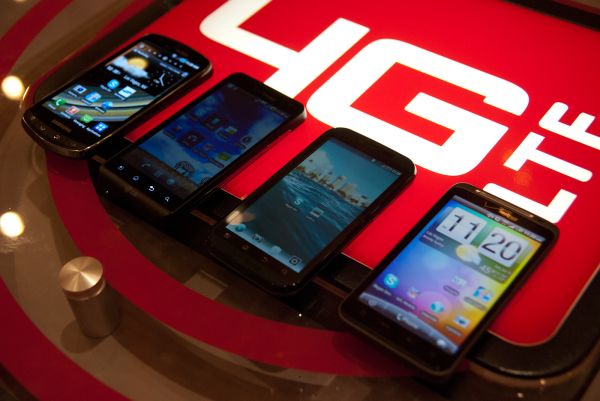
Verizon's 4G LTE Phone Lineup (Left to Right): Samsung Droid Charge, LG Revolution, Motorola Droid Bionic, HTC Thunderbolt
On the last day of CES 2011 I got what would be my last couple of minutes with the Thunderbolt, this time with working cellular connectivity and alongside a crowded lineup of other 4G LTE smartphones launching this year. No speedtests were allowed, just general web browsing. Even at that point, the Thunderbolt was talked about with hushed excitement - this device is furthest along in Verizon’s testing, the rep almost whispered to me. It’ll undoubtedly be the first, if the rest of testing continues as planned. It seemed that everyone knew that the Thunderbolt would be first, and that made it special.
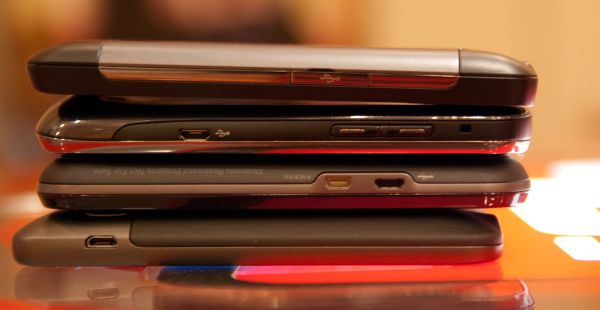
Verizon's 4G LTE Phone Lineup (Top to Bottom): LG Revolution, Samsung Droid Charge, Motorola Droid Bionic, HTC Thunderbolt
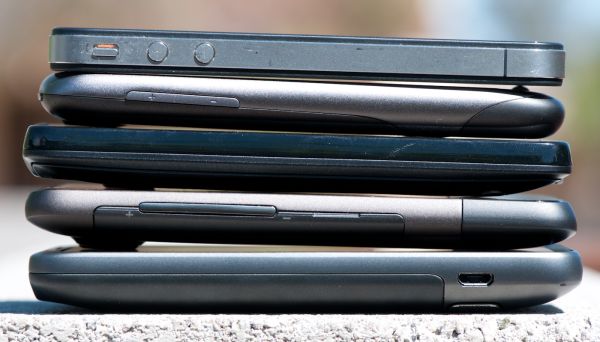
Top to Bottom: iPhone 4, Nexus One, HTC EVO, HTC Inspire, HTC Thunderbolt
The handset itself has a dominant full-hand feel, with good ergonomics. Thickness is where the Thunderbolt is really an outlier, at 13.2 mm, it’s considerably thicker than most of what else is launching lately. In the mass department as well, the Thunderbolt is specced at 173 grams with battery, though I measured 183.3 grams on my balance. As an aside, verifying size and mass is going to be another thing we’re doing going forward, especially after some notable specification confusion from back when I tackled the Fascinate.
Whether the Thunderbolt is simply too chunky depends on your hands and pockets, but there’s no denying that it’s large. Toss in the official double capacity battery which adds a square protrusion to the back, and it’s even larger. Again, simply by virtue of having a 4.3 inch screen, two cellular basebands and being stuffed full of antennas, the phone is going to be larger than average.


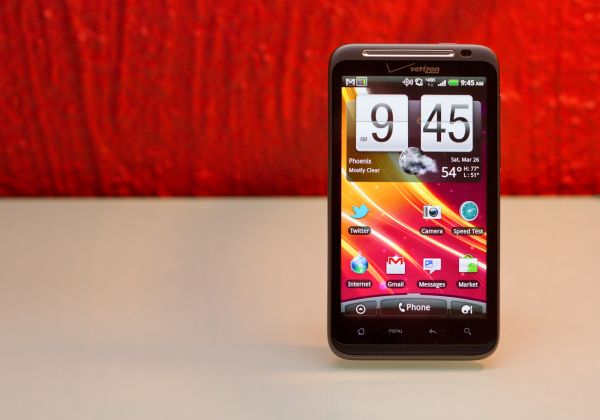
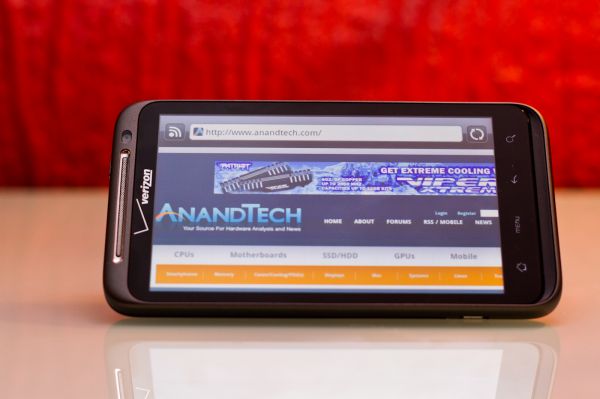














71 Comments
View All Comments
deadsix - Wednesday, April 27, 2011 - link
First of good review well done. I'm an Incredible 1 owner do you think I should wait for a the Droid Charge or the Bionic or snag a T-bolt now.Brian Klug - Wednesday, April 27, 2011 - link
Hard to say honestly - dual core (Tegra 2) will come with the Droid Bionic, and the Droid Charge we will have a review of shortly is Hummingbird + MDM9600. We'll also have the Incredible 2 piece up later this week. Lots of choices coming up!-Brian
michael2k - Wednesday, April 27, 2011 - link
How the heck do you live with that kind of battery life?sooper_anandtech12 - Wednesday, April 27, 2011 - link
You don't. Nearly everyone I know has returned the device. They're either rocking the LTE OnOff app to manually switch back and forth. Or it's sitting on a VZW shelf ready as a refurb device. Most people can't live with this kind of battery life. The guy who works in my office went off and bought an extended battery. It's seriously JITT. Makes a heavier and fat phone even more heavy and fat.hans007 - Wednesday, April 27, 2011 - link
i've had the tbolt for almost a month now.the battery life is really not that bad, i don't even turn off LTE and it makes it easily through a day.
you do have to charge it every day, but if you don't have like 700 widgets running it seems fine.
I had a G1 and a ton of other android phones. It really doesn't do much worse than the G2 I had, and it gets i'd say much better battery life than the G1 did. The only phone i've owned tha twas a lot better battery wise were a mytouch 3g slide and a optimus V which both happen to have basically the same arm11 600mhz "budget" 45nm cpu and much smaller screens.
HangFire - Wednesday, April 27, 2011 - link
I have a Thunderbolt. If I start the day with a full charge, make and take several calls, check e-mail and read e-mail hourly, and do a little surfing after dinner, the battery indicator is still green when I plug it in for the night.I took a trip to a neighboring city, forgot my charger, used Google Navigate satnav for an hour driving, used Google maps repeatedly, made and received several calls, used satnav an hour on the way home, after 9 hours it was just getting into the yellow.
Battery life is not ideal or a selling point, but it is a usable phone.
guoxing - Friday, June 24, 2011 - link
it's really a good cell phone if you want to buy it i suggest you go http://www.2011bestphone.com/?p=95 to knowAnnonymousCoward - Wednesday, April 27, 2011 - link
Why are so many smartphones advertised with that stupid huge flip clock...cmdrdredd - Thursday, April 28, 2011 - link
It's standard on HTC phones that's why. It's part of the UI they build into the base OS. If I am not mistaken it's a widget that you can turn off if you prefer.dagamer34 - Wednesday, April 27, 2011 - link
So it's a first-gen phone with some nice hardware, but ultimately something you wouldn't want to stick around with too long after 2nd and 3rd gen chipsets arrive with integrated GSM / CDMA / LTE solutions.My personal opinion? LTE is nice, but I'd stick to USB modems and mobile hotspots and go from there. Transition over to an integrated LTE smartphone once a) the OS fully supports it and b) there isn't crazy power drain.